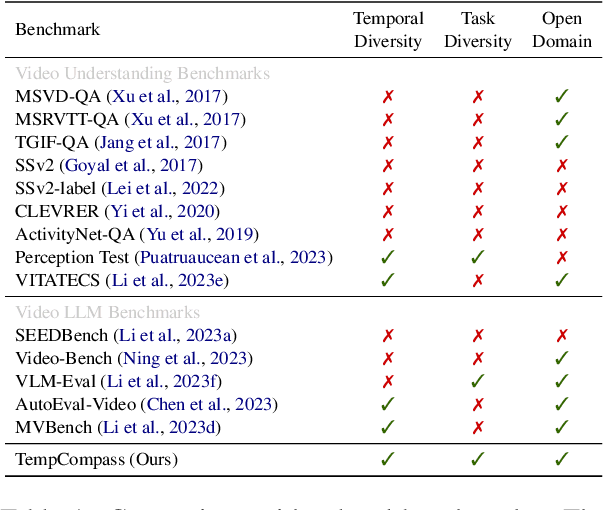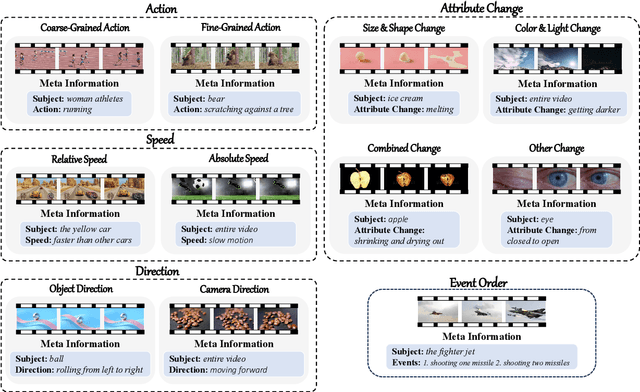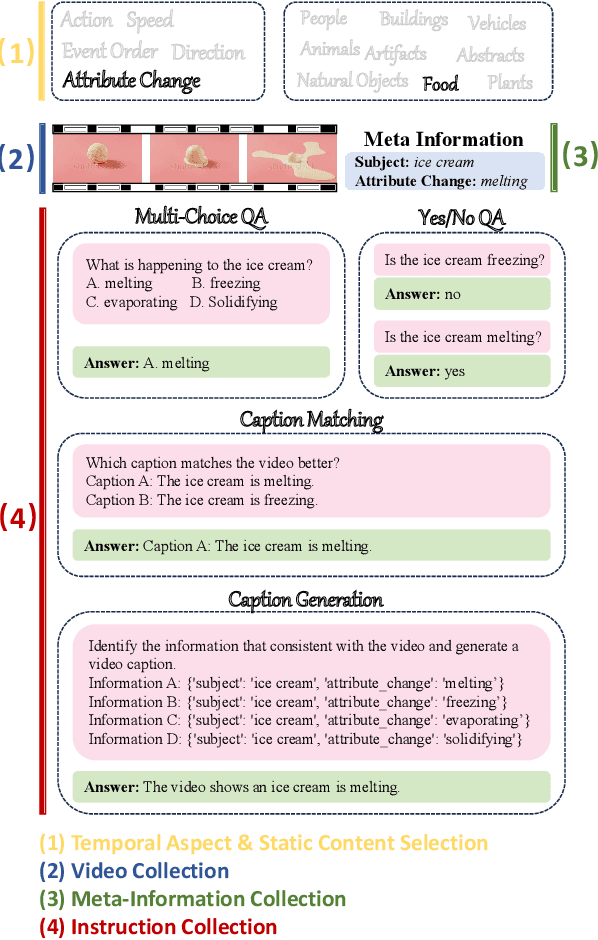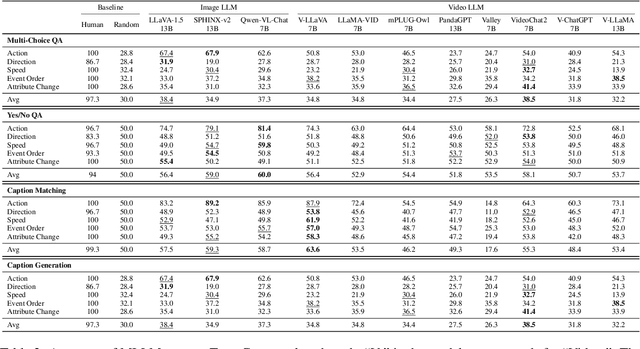Shuhuai Ren
Bridging Continuous and Discrete Tokens for Autoregressive Visual Generation
Mar 20, 2025Abstract:Autoregressive visual generation models typically rely on tokenizers to compress images into tokens that can be predicted sequentially. A fundamental dilemma exists in token representation: discrete tokens enable straightforward modeling with standard cross-entropy loss, but suffer from information loss and tokenizer training instability; continuous tokens better preserve visual details, but require complex distribution modeling, complicating the generation pipeline. In this paper, we propose TokenBridge, which bridges this gap by maintaining the strong representation capacity of continuous tokens while preserving the modeling simplicity of discrete tokens. To achieve this, we decouple discretization from the tokenizer training process through post-training quantization that directly obtains discrete tokens from continuous representations. Specifically, we introduce a dimension-wise quantization strategy that independently discretizes each feature dimension, paired with a lightweight autoregressive prediction mechanism that efficiently model the resulting large token space. Extensive experiments show that our approach achieves reconstruction and generation quality on par with continuous methods while using standard categorical prediction. This work demonstrates that bridging discrete and continuous paradigms can effectively harness the strengths of both approaches, providing a promising direction for high-quality visual generation with simple autoregressive modeling. Project page: https://yuqingwang1029.github.io/TokenBridge.
UVE: Are MLLMs Unified Evaluators for AI-Generated Videos?
Mar 13, 2025Abstract:With the rapid growth of video generative models (VGMs), it is essential to develop reliable and comprehensive automatic metrics for AI-generated videos (AIGVs). Existing methods either use off-the-shelf models optimized for other tasks or rely on human assessment data to train specialized evaluators. These approaches are constrained to specific evaluation aspects and are difficult to scale with the increasing demands for finer-grained and more comprehensive evaluations. To address this issue, this work investigates the feasibility of using multimodal large language models (MLLMs) as a unified evaluator for AIGVs, leveraging their strong visual perception and language understanding capabilities. To evaluate the performance of automatic metrics in unified AIGV evaluation, we introduce a benchmark called UVE-Bench. UVE-Bench collects videos generated by state-of-the-art VGMs and provides pairwise human preference annotations across 15 evaluation aspects. Using UVE-Bench, we extensively evaluate 16 MLLMs. Our empirical results suggest that while advanced MLLMs (e.g., Qwen2VL-72B and InternVL2.5-78B) still lag behind human evaluators, they demonstrate promising ability in unified AIGV evaluation, significantly surpassing existing specialized evaluation methods. Additionally, we conduct an in-depth analysis of key design choices that impact the performance of MLLM-driven evaluators, offering valuable insights for future research on AIGV evaluation. The code is available at https://github.com/bytedance/UVE.
Next Block Prediction: Video Generation via Semi-Autoregressive Modeling
Feb 12, 2025Abstract:Next-Token Prediction (NTP) is a de facto approach for autoregressive (AR) video generation, but it suffers from suboptimal unidirectional dependencies and slow inference speed. In this work, we propose a semi-autoregressive (semi-AR) framework, called Next-Block Prediction (NBP), for video generation. By uniformly decomposing video content into equal-sized blocks (e.g., rows or frames), we shift the generation unit from individual tokens to blocks, allowing each token in the current block to simultaneously predict the corresponding token in the next block. Unlike traditional AR modeling, our framework employs bidirectional attention within each block, enabling tokens to capture more robust spatial dependencies. By predicting multiple tokens in parallel, NBP models significantly reduce the number of generation steps, leading to faster and more efficient inference. Our model achieves FVD scores of 103.3 on UCF101 and 25.5 on K600, outperforming the vanilla NTP model by an average of 4.4. Furthermore, thanks to the reduced number of inference steps, the NBP model generates 8.89 frames (128x128 resolution) per second, achieving an 11x speedup. We also explored model scales ranging from 700M to 3B parameters, observing significant improvements in generation quality, with FVD scores dropping from 103.3 to 55.3 on UCF101 and from 25.5 to 19.5 on K600, demonstrating the scalability of our approach.
Next Token Prediction Towards Multimodal Intelligence: A Comprehensive Survey
Dec 30, 2024



Abstract:Building on the foundations of language modeling in natural language processing, Next Token Prediction (NTP) has evolved into a versatile training objective for machine learning tasks across various modalities, achieving considerable success. As Large Language Models (LLMs) have advanced to unify understanding and generation tasks within the textual modality, recent research has shown that tasks from different modalities can also be effectively encapsulated within the NTP framework, transforming the multimodal information into tokens and predict the next one given the context. This survey introduces a comprehensive taxonomy that unifies both understanding and generation within multimodal learning through the lens of NTP. The proposed taxonomy covers five key aspects: Multimodal tokenization, MMNTP model architectures, unified task representation, datasets \& evaluation, and open challenges. This new taxonomy aims to aid researchers in their exploration of multimodal intelligence. An associated GitHub repository collecting the latest papers and repos is available at https://github.com/LMM101/Awesome-Multimodal-Next-Token-Prediction
Parallelized Autoregressive Visual Generation
Dec 19, 2024



Abstract:Autoregressive models have emerged as a powerful approach for visual generation but suffer from slow inference speed due to their sequential token-by-token prediction process. In this paper, we propose a simple yet effective approach for parallelized autoregressive visual generation that improves generation efficiency while preserving the advantages of autoregressive modeling. Our key insight is that parallel generation depends on visual token dependencies-tokens with weak dependencies can be generated in parallel, while strongly dependent adjacent tokens are difficult to generate together, as their independent sampling may lead to inconsistencies. Based on this observation, we develop a parallel generation strategy that generates distant tokens with weak dependencies in parallel while maintaining sequential generation for strongly dependent local tokens. Our approach can be seamlessly integrated into standard autoregressive models without modifying the architecture or tokenizer. Experiments on ImageNet and UCF-101 demonstrate that our method achieves a 3.6x speedup with comparable quality and up to 9.5x speedup with minimal quality degradation across both image and video generation tasks. We hope this work will inspire future research in efficient visual generation and unified autoregressive modeling. Project page: https://epiphqny.github.io/PAR-project.
Video-MME: The First-Ever Comprehensive Evaluation Benchmark of Multi-modal LLMs in Video Analysis
May 31, 2024



Abstract:In the quest for artificial general intelligence, Multi-modal Large Language Models (MLLMs) have emerged as a focal point in recent advancements. However, the predominant focus remains on developing their capabilities in static image understanding. The potential of MLLMs in processing sequential visual data is still insufficiently explored, highlighting the absence of a comprehensive, high-quality assessment of their performance. In this paper, we introduce Video-MME, the first-ever full-spectrum, Multi-Modal Evaluation benchmark of MLLMs in Video analysis. Our work distinguishes from existing benchmarks through four key features: 1) Diversity in video types, spanning 6 primary visual domains with 30 subfields to ensure broad scenario generalizability; 2) Duration in temporal dimension, encompassing both short-, medium-, and long-term videos, ranging from 11 seconds to 1 hour, for robust contextual dynamics; 3) Breadth in data modalities, integrating multi-modal inputs besides video frames, including subtitles and audios, to unveil the all-round capabilities of MLLMs; 4) Quality in annotations, utilizing rigorous manual labeling by expert annotators to facilitate precise and reliable model assessment. 900 videos with a total of 256 hours are manually selected and annotated by repeatedly viewing all the video content, resulting in 2,700 question-answer pairs. With Video-MME, we extensively evaluate various state-of-the-art MLLMs, including GPT-4 series and Gemini 1.5 Pro, as well as open-source image models like InternVL-Chat-V1.5 and video models like LLaVA-NeXT-Video. Our experiments reveal that Gemini 1.5 Pro is the best-performing commercial model, significantly outperforming the open-source models. Our dataset along with these findings underscores the need for further improvements in handling longer sequences and multi-modal data. Project Page: https://video-mme.github.io
DeCo: Decoupling Token Compression from Semantic Abstraction in Multimodal Large Language Models
May 31, 2024



Abstract:The visual projector, which bridges the vision and language modalities and facilitates cross-modal alignment, serves as a crucial component in MLLMs. However, measuring the effectiveness of projectors in vision-language alignment remains under-explored, which currently can only be inferred from the performance of MLLMs on downstream tasks. Motivated by the problem, this study examines the projector module by interpreting the vision-language semantic flow within MLLMs. Specifically, we trace back the semantic relevance flow from generated language tokens to raw visual encoder patches and the intermediate outputs produced by projectors. Our findings reveal that compressive projectors (e.g., QFormer), abstract visual patches into a limited set of semantic concepts, such as objects or attributes, resulting in a 'double abstraction' phenomenon. This involves a first visual semantic abstraction by the projector referring to pre-defined query tokens, and a second extraction by the LLM based on text instructions. The double abstraction is inefficient in training and will result in cumulative vision semantics deficiency. To mitigate this issue, we propose the key insight of 'Decouple Compression from Abstraction (DeCo), that is compressing the visual token number at the patch level by projectors and allowing the LLM to handle visual semantic abstraction entirely. Consequently, we adopt a simple compressor, i.e., 2D Adaptive Pooling, to downsample visual patches in a parameter-free manner. Empirical evaluation demonstrates that DeCo surpasses traditional compressive projectors regarding both performance and efficiency. It achieves performance gains of 0.9%, 7.1%, and 2.9% across the MLLM Benchmarks, Visual Localization, and Open-ended VQA tasks with fewer trainable parameters and faster convergence speed.
LaDiC: Are Diffusion Models Really Inferior to Autoregressive Counterparts for Image-to-Text Generation?
Apr 16, 2024



Abstract:Diffusion models have exhibited remarkable capabilities in text-to-image generation. However, their performance in image-to-text generation, specifically image captioning, has lagged behind Auto-Regressive (AR) models, casting doubt on their applicability for such tasks. In this work, we revisit diffusion models, highlighting their capacity for holistic context modeling and parallel decoding. With these benefits, diffusion models can alleviate the inherent limitations of AR methods, including their slow inference speed, error propagation, and unidirectional constraints. Furthermore, we identify the prior underperformance of diffusion models stemming from the absence of an effective latent space for image-text alignment, and the discrepancy between continuous diffusion processes and discrete textual data. In response, we introduce a novel architecture, LaDiC, which utilizes a split BERT to create a dedicated latent space for captions and integrates a regularization module to manage varying text lengths. Our framework also includes a diffuser for semantic image-to-text conversion and a Back&Refine technique to enhance token interactivity during inference. LaDiC achieves state-of-the-art performance for diffusion-based methods on the MS COCO dataset with 38.2 BLEU@4 and 126.2 CIDEr, demonstrating exceptional performance without pre-training or ancillary modules. This indicates strong competitiveness with AR models, revealing the previously untapped potential of diffusion models in image-to-text generation.
Towards Multimodal Video Paragraph Captioning Models Robust to Missing Modality
Mar 28, 2024



Abstract:Video paragraph captioning (VPC) involves generating detailed narratives for long videos, utilizing supportive modalities such as speech and event boundaries. However, the existing models are constrained by the assumption of constant availability of a single auxiliary modality, which is impractical given the diversity and unpredictable nature of real-world scenarios. To this end, we propose a Missing-Resistant framework MR-VPC that effectively harnesses all available auxiliary inputs and maintains resilience even in the absence of certain modalities. Under this framework, we propose the Multimodal VPC (MVPC) architecture integrating video, speech, and event boundary inputs in a unified manner to process various auxiliary inputs. Moreover, to fortify the model against incomplete data, we introduce DropAM, a data augmentation strategy that randomly omits auxiliary inputs, paired with DistillAM, a regularization target that distills knowledge from teacher models trained on modality-complete data, enabling efficient learning in modality-deficient environments. Through exhaustive experimentation on YouCook2 and ActivityNet Captions, MR-VPC has proven to deliver superior performance on modality-complete and modality-missing test data. This work highlights the significance of developing resilient VPC models and paves the way for more adaptive, robust multimodal video understanding.
TempCompass: Do Video LLMs Really Understand Videos?
Mar 01, 2024



Abstract:Recently, there is a surge in interest surrounding video large language models (Video LLMs). However, existing benchmarks fail to provide a comprehensive feedback on the temporal perception ability of Video LLMs. On the one hand, most of them are unable to distinguish between different temporal aspects (e.g., speed, direction) and thus cannot reflect the nuanced performance on these specific aspects. On the other hand, they are limited in the diversity of task formats (e.g., only multi-choice QA), which hinders the understanding of how temporal perception performance may vary across different types of tasks. Motivated by these two problems, we propose the \textbf{TempCompass} benchmark, which introduces a diversity of temporal aspects and task formats. To collect high-quality test data, we devise two novel strategies: (1) In video collection, we construct conflicting videos that share the same static content but differ in a specific temporal aspect, which prevents Video LLMs from leveraging single-frame bias or language priors. (2) To collect the task instructions, we propose a paradigm where humans first annotate meta-information for a video and then an LLM generates the instruction. We also design an LLM-based approach to automatically and accurately evaluate the responses from Video LLMs. Based on TempCompass, we comprehensively evaluate 8 state-of-the-art (SOTA) Video LLMs and 3 Image LLMs, and reveal the discerning fact that these models exhibit notably poor temporal perception ability. Our data will be available at \url{https://github.com/llyx97/TempCompass}.
 Add to Chrome
Add to Chrome Add to Firefox
Add to Firefox Add to Edge
Add to Edge